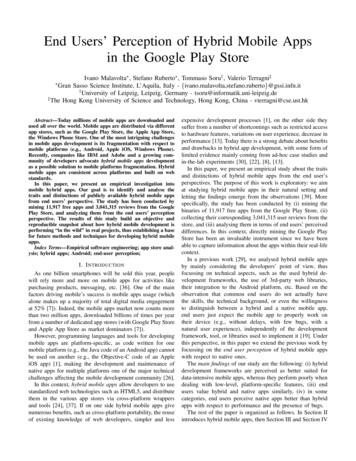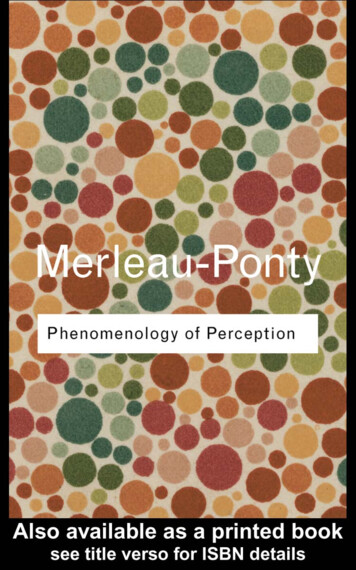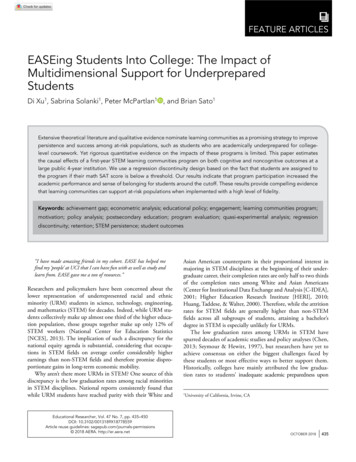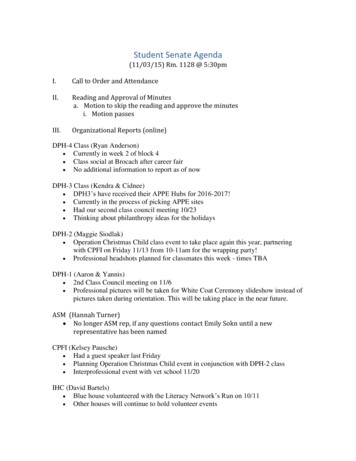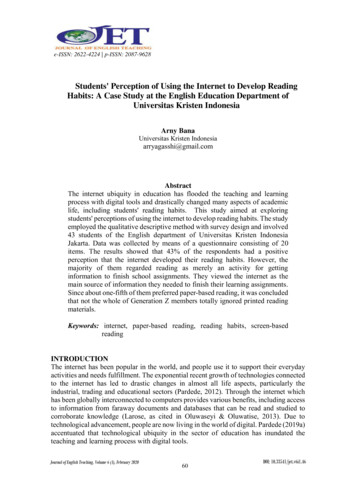
Transcription
e-ISSN: 2622-4224 p-ISSN: 2087-9628Students' Perception of Using the Internet to Develop ReadingHabits: A Case Study at the English Education Department ofUniversitas Kristen IndonesiaArny BanaUniversitas Kristen Indonesiaarryagasshi@gmail.comAbstractThe internet ubiquity in education has flooded the teaching and learningprocess with digital tools and drastically changed many aspects of academiclife, including students' reading habits. This study aimed at exploringstudents' perceptions of using the internet to develop reading habits. The studyemployed the qualitative descriptive method with survey design and involved43 students of the English department of Universitas Kristen IndonesiaJakarta. Data was collected by means of a questionnaire consisting of 20items. The results showed that 43% of the respondents had a positiveperception that the internet developed their reading habits. However, themajority of them regarded reading as merely an activity for gettinginformation to finish school assignments. They viewed the internet as themain source of information they needed to finish their learning assignments.Since about one-fifth of them preferred paper-based reading, it was concludedthat not the whole of Generation Z members totally ignored printed readingmaterials.Keywords: internet, paper-based reading, reading habits, screen-basedreadingINTRODUCTIONThe internet has been popular in the world, and people use it to support their everydayactivities and needs fulfillment. The exponential recent growth of technologies connectedto the internet has led to drastic changes in almost all life aspects, particularly theindustrial, trading and educational sectors (Pardede, 2012). Through the internet whichhas been globally interconnected to computers provides various benefits, including accessto information from faraway documents and databases that can be read and studied tocorroborate knowledge (Larose, as cited in Oluwaseyi & Oluwatise, 2013). Due totechnological advancement, people are now living in the world of digital. Pardede (2019a)accentuated that technological ubiquity in the sector of education has inundated theteaching and learning process with digital tools.Journal of English Teaching, Volume 6 (1), February 202060DOI: 10.33541/jet.v6i1.46
BanaWorld of digital which is connected to the internet can provide any kind ofinformation people want to know, and this has changed the habit of students in collectingdata. Instead of visiting the library to find printed books, students tend to access digitaltexts through the internet. The internet does not merely provide information for studentsbut also facilitating tools for discussing class materials and sharing academic issuesthrough various social media (Salas & Alexander, as cited in Gok, 2016). In terms oflanguage learning, Pardede (2019b) stated that information and communicationtechnologies that are connected to the internet have even provided a growing range ofpossible solutions for refining the teaching and learning inputs, processes, and outcomes.Technological ubiquity has really brought people to live in the digital world, andone of the main impacts is that people in general and students, in particular, spend moreand more time accessing digital tools. Liu (as cited in Harafsheh & Pandian, 2016) foundthat “with the emergence of digital society, most people particularly adolescents aredevoting much more time to reading electronic resources. They spend their timeskimming, downloading and browsing information on the internet” (p. 18). Today’sstudents prefer to stay in one place and access the internet to read while doing anotheractivity not just focus in one place and read lots of documents. Statista ResearchDepartment (2014) conveyed that though only 10.03 million e-books were sold in 2008in the U.S., the sale increased to 457.09 million units by 2014. VitalSource TechnologiesInc. (2015) found that the students using digital tools to read course material increasedfrom 63% (2011) to 87% (2015), and those reading digital course materials frequentlyincreased from 48% (2011) to 78% (2015).In the current academic life, the use of digital texts is inescapable (Pardede, 2017)and it has significantly impacted students’ attitudes and reading habits. According toChou and Hsiao (as cited in Oluwaseyi (2013) "the internet becomes an important partof college students' lives, not only for their studies and daily routine but as a tool forgetting to know other people and the rest of the world" (p. 40). Several studies (Ackerman& Lauterman, 2012; Abanomey, 2013; Huang, 2014; Taj et.al. 2017) have beenconducted to investigate the effectiveness of digital reading vs. printed reading. Somestudies (Chauhan & Lal, 2012; Gay et al., 2006) have been also carried out to investigatethe changes caused by digital texts to students’ reading habits. However, studiesinvestigating students’ perception of the use of the internet to develop reading habits arestill rare. As an attempt to fill in the gap, the present study was conducted to find outstudents' perception of using the internet to develop reading habits.Based on the background above, the research question to be answered in this studywas formulated as follows "What is students' perception of using the internet to developtheir reading habits?”LITERATURE REVIEWReadingReading is very vital for the overall improvement of a human being. According to Chettriand Rout (2013), reading affords experience through which an individual may enlarge hishorizons of knowledge, identify, spread and increase his awareness and advances a deeperunderstanding of himself, of other people and of the world. In the context of education, alarge amount of reading is essential because all learning activities involve reading skillsand the success of students' study also depends on the greater part in their ability to read.Bashir and Mattoo (2012) emphasized that both reading and academic success areconsistent and dependent relative to each other. Thus, the more students read books, theJournal of English Teaching, Volume 6 (1), February 2020DOI: 10.33541/jet.v6i1.4661
Banamore successful they will be in learning. Additionally, Palani (2012) stated that readingis interconnected with the total educational development and educational achievementneeds successful reading. Krashen’s (2004) study revealed that people with good readinghabits tend to score better on all kinds of tests.In the EFL context, reading is essentially the most important skill every learnershould master. Pardede (2019a) identified three reasons why reading is crucial for EFLlearners. First, EFL learners lack inputs from their daily interactions because English isnot the primary language of the society where they study it. To overcome the inputlimitation, reading is the best solution. Secondly, reading significantly contributes toone’s personal and intellectual development, further studies, job success, and careerdevelopment, and the capability to meet changes. Third, reading skills enhance a learner'smastery of other areas of language teaching because it offers the learners with variousgood sentence structures so many times that they become accustomed to them. Readingalso develops EFL learners’ vocabulary by letting them get the most frequently used anduseful words and learn them in context. It also improves writing skills for it enables thelearners to figure out how to express ideas through words, how to use punctuationcorrectly, and so on. Reading is even the basis of instruction in all aspects of languagelearning. In the past, reading was used to be defined as the ability to read and interpretmeaning from varied texts. Widdowson (1979), for instance, defines reading as "theprocess of getting linguistic information via print". The expression "getting information",appears to imply that reading is a linear process by which readers decode a text word byword, linking the words into phrases and then sentences. Due to a better understanding ofreading, current definitions view reading as a complex activity involving theunderstanding process of a whole text composed of written symbols. It is not regarded asa passive mechanical activity anymore but purposeful and rational, reliant on the reader’sprior knowledge and expectations. Cline et.al (2006, p. 2) state that reading is “the processof deriving meaning from the text”. For Toit (2001), reading is a process of thinking,recalling and relating concepts under the functioning of texts. In short, it is apsycholinguistic guessing game, a process in which readers sample the text, makehypotheses, confirm or reject them, make new hypotheses, and so forth.Reading HabitsReading habit refers to the behavior which expresses the likeness of reading of individualtypes of reading and tastes of reading (Sangkaeo, 1999). It is a pattern with which anindividual organizes his or her reading in terms of the type, content, and quantity ofmaterials read, the reading frequency and the average time spent on reading. A personwith a good reading habit makes reading a regular activity. In short, reading habit is theactivity of deriving meaning from the text which is conducted frequently.These definitions indicate that reading habit is personal because it is affected by anindividual environment, education, gender, and age. According to Azikiwe (1998),reading habit is "the adopted way and manner a student plans his private readings, afterclassroom learning so as to attain mastery of the subject". According to her, "good readinghabits are good assets to learners because they (habits) assist students to attain mastery inareas of specialization and consequent excellent performance, while opposite constitutesconstraints to learning and achievement leading to failure".The results of some current researches on reading habits have discovered thatreading habits are associated with students' gender, age, educational background,Journal of English Teaching, Volume 6 (1), February 2020DOI: 10.33541/jet.v6i1.4662
Banaacademic performance, and professional growth. According to Cesar, et.al (2010), thereare six indicators of reading habit. First, reading frequency, i.e. the frequency at whichthe person reports to read books in their spare time. Moreover, reading frequency is theactivity when someone does to read for some minutes or hours as frequently. Second,books read, which refer to the number of books that the person reports having read in thelast three months. It is considered from the amount of books. Third, time spent onacademic reading, i.e., the time that the person reports to devote to reading books on hisor her study subjects. It is considered from the time reported as devoted to “Books forClass”. Fourth, time spent on non-academic reading, which refers to the time that therespondent reports to devote to reading books that are not directly related to the subjectsof his or her studies. It is considered from the time reported as devoted to “Books that arenot for class”. Fifth, motivation in the family environment, which is often reported by theperson on the purchase of books, recommending books and reading interest in the family.Finally, motivation in the academic environment, i.e., the frequency the student reportson the teacher using activities to promote contact with psychology literature.Impact of the Internet on Reading HabitsRealizing the importance of reading, its development has been regarded as the firstpriority in EFL and printed texts have long played a great role in EFL classrooms.However, the increasing use of digital text in EFL learning and teaching due to the influxof digital tools has caused a fundamental change in the ways students read today (Pardede,2019a). The internet has changed not only the way people communicate, how business isdone, how entertainment is received, and how information is shared and received. It hasalso had a great effect on people’s reading habits. Shen (as cited in Tanjung, Ridwan &Gultom, 2017) even said that digital reading "is a new kind of reading habits at which(EFL) students preferred internet-based reading than paper-based one" and "with thegrowing amount of digital information available, people particularly young adults arefound spending more time reading electronic materials" (p. 147).Digital texts have two main types: the one accessed from the internet and those keptin screen reading tools, computers or hand handled devices. Both are electronicallygenerated and multimodal (blending texts with audio, video, image, and hypertext). Suchfeatures make them more interactive than a printed text and bid the reader to explore in anonlinear way. Hypertext, in particular, makes a digital text interconnected with manyother texts which offer the readers various directional choices fitting to their interest. So,a single text can provide different access routes and, therefore, different options ofreading. In this context, the hyper-textual nature promotes a flexible pattern of discoverythat fosters readers’ greater cognitive effort for they must construct informationframeworks based on the nature of the paths chosen (Spires & Estes, 2002).Digital reading has both advantages and disadvantages for students. On the onehand, it makes reading and information accessibility easier and more enjoyable. On theother hand, it poses a threat to reading culture. One of the advantages of internet-basedreading is that reading is now not focused on one place, silent and starts to read. Studentscan now read anywhere and anytime as long as they feel enjoy and comfortable. Anotheradvantage is that using the internet-connected with media technology (computer) cangenerate a big motivation and enthusiasm to read. This fact is evidence that students havea favorable perception of the use of the internet in learning reading comprehensionsubjects. Sudiran (2015) listed several benefits of the internet-based-reading: (1)motivating students; (2) improving the quality of learning processes; (3) reducing theJournal of English Teaching, Volume 6 (1), February 2020DOI: 10.33541/jet.v6i1.4663
Banamisunderstanding among students; (4) increasing the students' curiosity; and (5)increasing the students' competitiveness to achieve their goals" (p. 687). Currently, mostpeople believe that the success of graduates of each college or school is depending onhow they learn to apply or use the internet as a source for gathering information. As ameans of increasing knowledge, the internet plays a key role in learning readingcomprehension because it helps students acquired much information from which theirachievement has developed. The use of the internet for reading English makes studentsmore capable and creative in learning.However, various previous studies tended to suggest that printed or paper-basedreading was superior to digital or screen-based reading tasks in terms of speed, accuracy,and comprehension. Dillon (1994) found that reading from a screen was almost 20 to 30%slower with regard to performance than a paper. Mayes et al. (2001) also found computerbased reading significantly slower. However, a more recent study (Solak, 2014) revealedthat reading speed on a screen reading was nearly 12% faster than paper-based reading.In terms of accuracy, various studies (Muter et al., 1982; Creed et al., 1987; Ziefle, 1998)found that that print reading was superior to digital reading. However, Creed et al. (1987)found no significant difference between the two reading modes. In terms ofcomprehension, various studies (Macedo-Rouet et al., 2003; Mangen et.al. 2013; Solak,2014) showed paper-based reading supremacy, while others (Abanomey, 2013; Aydemiret.al. 2013; Huang, 2014; Taj et.al. 2017) found that digital reading outperformed paperbased reading for comprehension.These contradictive results of studies investigating the effect of paper-based readingversus screen-based reading to reading speed, accuracy, and comprehension, accordingto Pardede (2017) is due to two factors. First, the varieties of the study designs, includingthe heterogeneity of the subjects’ age-group and sample size inadequacy, varied settings,diverse independent and dependent variables, unclear measures validity and reliability,and inappropriate mastery or even absence of digital reading strategies among theparticipants. Second, the various advancement levels of the technology employed in thestudy.Numerous recent studies (Jeong, 2012; Lim & Hew, 2014) examining students'and teachers' perceptions of digital reading focus on the use of e-books commonlyrevealed that more than 50% of users who had used e-book s were satisfied with theirexperience of using them. Pardede (2019) found that pre-service English teachersperceived digital modules use in blended learning positively. But they expected themodules to be written in ‘easier’ language and accompanied by relevant videos. Jeong(2012) indicated that Korean students approved e-books. The students also admitted thecurrent e-book's usefulness. Lim and Hew (2014) found that students generally heldpositive attitudes toward e-book.Some other studies focused on comparing the preference for digital texts with theircounterparts. Abdullah and Gibb (2008) revealed that users still prefer reading paperbooks for various reasons: preference of the feel for real books, disinclination to read onthe screen, or difficulty to purchase the equipment. However, Eden and Eshet-Alkalai’s(2013) study showed no significant differences in readers’ average scores on the twoformats, but participants reading the digital format finished their assignments faster.METHODThis study is qualitative research with descriptive design employing the survey method.The participants were 43 students of the English Education Department Faculty ofJournal of English Teaching, Volume 6 (1), February 2020DOI: 10.33541/jet.v6i1.4664
BanaTeacher Training and Education, Universitas Kristen Indonesia. Data was collected bymeans of a questionnaire consisting of twenty statements. This questionnaire had beenvalidated by Sudiran (2015) and the researcher only adopted it according to the needs ofthis research. The participants responded to each statement by choosing one of the fiveoptions designed in the form of a Likert Scale. The obtained data were analysed usingdescriptive statistics.FINDINGS AND DISCUSSIONPerception of Using the InternetTable 1 shows that overall, the participants had a positive attitude towards using theinternet. More than 2/3 of the respondents were used to read online or access the internetfor getting the information they need in their study. The majority believed they couldaccess the internet quite easily. This confirms the idea that being the members ofGeneration Z, the participants were 'tech-savvy’. They were the first generation born intoa globally (internet) connected world and therefore “live and breathe” technology(Cilliers, 2017). That's why they did not find any difficulty in using information andcommunication technologies and could quickly access the information they needed.Being tech-savvy, they also believed the internet as the main means to connect them tothe world.Table 1. Students’ Perception of Using the InternetSDDNASAI do reading on learning Englishthrough Internet.I enjoy reading e-book or articlesthrough the 0(47%)F(%)26(60%)14(33%)F(%)4(9%)3(7%)3.Reading using the internet developsmy reading ability at the campus1(2%)2(5%)14(33%)20(47%)6(14%)3.654.It’s easy and quick to read onlinefor information,0(0%)3(7%)5(12%)26(60%)9(21%)3.955.The Internet drives me to readevery day.I have a particular time to readusing the internet every %)6(14%)3(7%)3.44I feel confident using the searchingmachine (Yahoo & Google) to findnecessary textsThe Internet motivates me to readand explore many topics I have notseen.The Internet makes me connectedto the world especially, throughreading.0(0%)3(7%)12(28%)25
2019a). The internet has changed not only the way people communicate, how business is done, how entertainment is received, and how information is shared and received. It has also had a great effect on people’s reading habits. Shen (as cited in Tanjung, Ridwan & Gultom, 2017) even said that digital reading "is a new kind of reading habits at which


